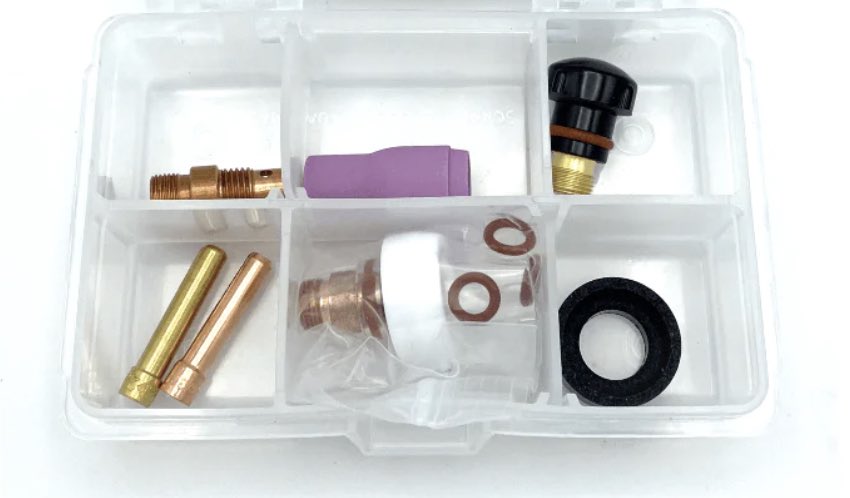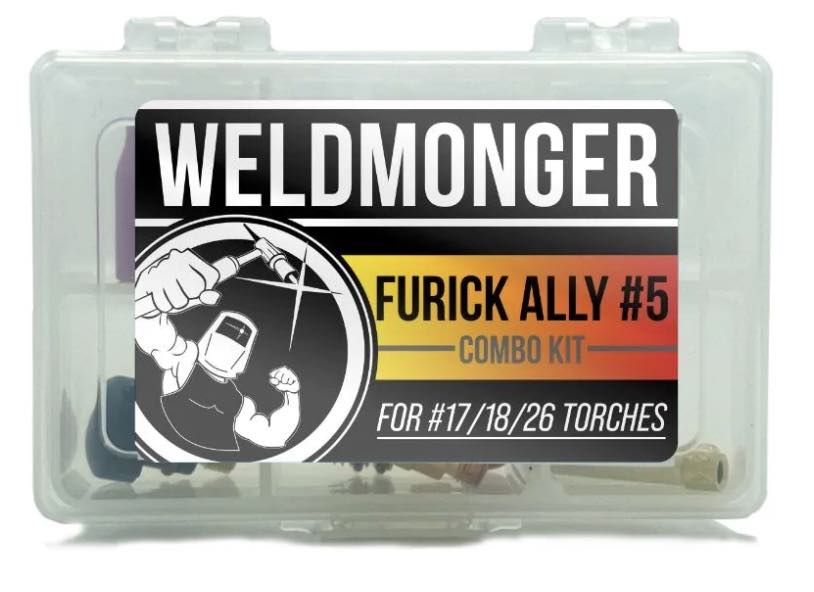3G Aluminum Full Penetration Butt Joint
There is a reason so many top welders like a #5 cup for getting full penetration on aluminum. learn more at weldmonger.com
This #5 combo kit includes a clear #5 as well as a ceramic #5 cup along with collet body and all the parts needed to fit your torch. We have a kit for #9-20 style torches as well as 17, 18, 26 style .
A 3g weld joint is a vertical butt joint and usually requires complete smooth penetration.
So how do achieve smooth full penetration on .125" 3.2mm thick 6061 aluminum?
Of course the right settings and techniques help but one thing that also helps a lot is cleaning the edges of the joint.
A dedicated file works well but there are also some flap discs designed for aluminum that work well.
An ordinary flap disc designed for steel will often load up with aluminum and that can cause a lot of heat and smearing of oxides into the surface you are trying to clean.
For that reason , a file often works better than an plain flap disc.
I rounded the tip for this weld by setting the AC balance to max cleaning.
Maximum cleaning action puts more electrode positive into the AC cycle and heats up the tip of the electrode more.
On older transformer tig welding machines, we used to switch polarity to DCEP to round the tip of the tungsten but on todays inverters with the AC balance feature, its easier just to set the AC balance to max cleaning.
I usually just let the tip round by itself but I thought I would experiment since I was using a #5 cup to see if a rounded tip would provide a bit more cleaning action than a tapered tip.
I am not sure it helped but the weld did turn out ok.
I used 3/32" 2% lanthanated tungsten and a 3/32" 4043 filler rod for this weld along with a clear ally 5 cup.
In TIG welding aluminum, alternating current (AC) plays an important role in providing a cleaning action, which is essential due to aluminum’s natural oxide layer.
Here's how AC provides this cleaning effect:
- Aluminum Oxide Layer: Aluminum forms a tough oxide layer on its surface (aluminum oxide), which has a much higher melting point (about 3,700°F) than aluminum itself (about 1,200°F). This oxide layer needs to be removed for a good weld to form.
- AC Alternating Between Positive and Negative Cycles:In DC positive (electrode positive) cycles, the electrode is positive, and the workpiece is negative. This causes electrons to flow from the aluminum to the electrode, which creates a cleaning action. This cleaning action breaks up and removes the oxide layer from the aluminum’s surface, exposing clean metal for welding.In DC negative (electrode negative) cycles, the heat is directed to the aluminum workpiece, which penetrates the weld and melts the aluminum itself.
- Cleaning Action During Positive Cycles: When the cycle is electrode positive, the bombardment of electrons cleans the aluminum surface by breaking up the oxide layer, essentially blasting it off. This leaves a clean surface, which is key for forming a strong, defect-free weld.
- Balanced Penetration and Cleaning: The alternating nature of AC allows a balance between the cleaning action (positive cycle) and heat for melting (negative cycle). Too much cleaning could reduce weld penetration and heat up the tungsten too much, and too much penetration could leave oxides on the weld, so the balance in AC is key for aluminum TIG welding.
This cleaning action is what makes AC the preferred current for TIG welding aluminum, as it ensures both oxide removal and proper fusion of the base metal.
Of course there are exceptions like TIG welding aluminum with helium on DCEN.

















